 |
Elegant mariposa lily, Calochortus
elegans Pursh (left).
The flower is about an inch across. It was first collected by Meriwether
Lewis on May 17, 1806, near today's Kamiah, Idaho. Botanist Frederick Pursh
recognized that the plant was new to science. He coined the name
Calochortus (from the Greek “beautiful plant”) for a new
genus, giving the plant the name that it has today. We have not seen the
plant growing south of the Clearwater River.
White mariposa lily, (also star tulip),
Calochortus eurycarpus S. Watson
(right) has a deep purple spot oneach petal adjacent to
a basal, bristle-lined, yellow to green “gland.” The petals are
delta-shaped with a small point; the sepals are only a little longer than
the petals. Great numbers appear in early to mid-summer in our mountains,
where the plants grow almost to treeline. This species name means “broad
seed,” from the Greek. This plant is known regionally as a
“sego lily,” although the true sego lily is Calochortus
nuttallii, the Utah state flower, a Great Basin plant. |
 |
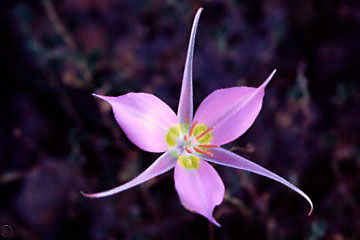 |
Sagebrush mariposa lily, Calochortus
macrocarpus
Douglas (left) is a montane, foothill plant that
blooms in mid- to late summer on dry sagebrush slopes, south of the
Clearwater River drainage. The species name means “long fruit”
for the shape of the fruit. The three petals and three sepals are the same
color, ranging from pure white to deep lavender. Narrow sepals are
noticeably longer than the petals; the latter are ovoid to deltoid shaped
with pointed (acuminate) tips. A prominent, central green band runs
down the back of each petal. A rounded basal gland at the base of each petal
is fringed with a border of prominent hairs; this in turn, in some varieties,
is bordered above by a reddish bar not present in ours. (The
plants pictured here differ from varieties that grow further to the west
in that the petals are longer, the "beard" at the base of the petals also
differs; our plants--photographed and collected in the Sun Valley area--
may represent an as yet undescribed variety of Calochortus
macrocarpus). |
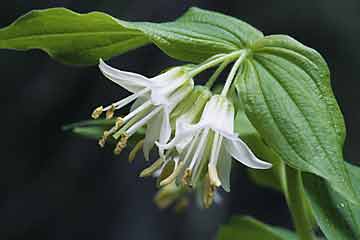 |
Fairy bells, Prosartes
trachycarpa S.
Watson (left, right) grow in the shade of evergreen forests
at higher altitudes. They are easily identified by their wide, parallel-veined
leaves and long-stalked lily-like, paired flowers . The ovaries mature into
bright red, irregularly shaped berries, said to be edible, but tasteless.
Until recently this plant was classified as Disporum trachycarpum.
|
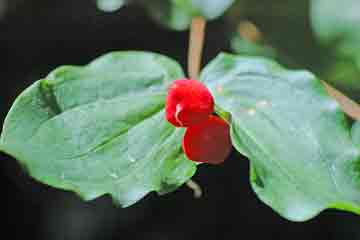 |
 |
Clintonia, Clintonia uniflora
(Menzies ex Schultes) Kunth (right,left). Clintonias
(also "bead-lilies") are shade-loving, montane to subalpine plants
with a six-tepaled, single white flower (uniflora). Their stems arise
from a cluster of two or more wide, rather leathery leaves. Each plant bears
one blue berry. The name, Clintonia, honors amateur naturalist DeWitt
Clinton (1769-1828), known for his political career as a senator, presidential
candidate, promoter of steam navigation, and governor of New York. |
 |
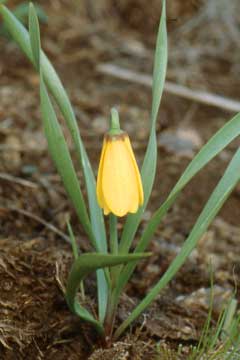 |
Yellow bell, Fritillaria pudica
(Pursh) Spreng. (left, right) Yellow-bells bloom in
April at lower elevations and well into June higher up, as single plants,
or in small groups. Narrow, twisted leaves appear first, followed by six-tepaled,
yellow-orange flowers. The species name, pudica, means
“modest,” for the shy, downward facing
flowers. Fritillaria was derived from a Latin word for
“dice-box,” presumably for the seed-containing capsule (right).
Lewis and Clark collected the plant on the Clearwater River (May 8,
1806). |
 |
 |
Checker lily Fritillaria
affinis (Schultes)
Sealy (left), and Chocolate lily,
Fritillaria atropurpurea Nutt. (right). These two
plants are clearly related, although their ranges differ. Both bloom about
a month later than the yellow-bell shown above. The chocolate lily grows
in the southern half of Idaho; the checker lily grows in the northern half.
Neither plant is particularly common and finding one is a cause for comment.
Fritillaries are sometimes called “rice-roots” for a myriad of
tiny bulblets attached to a main bulb. Lewis and Clark collected Fritillaria
affinis while ascending the Columbia River (April 10, 1806). |
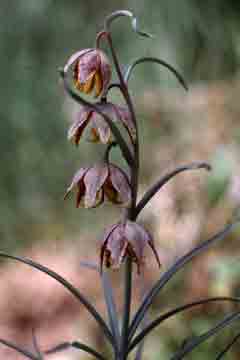 |
 |
Clasping-leaf twisted-stalk, Streptopus
amplexicaulis (L.)
DC. (left, right). The twisted-stalk’s stem zigzags
from one leaf node to the next as reflected in its generic name,
Streptopus (from the Greek meaning “twisted foot”) and its
stemless leaves clasp the main stem (amplexicaulis means "stem-clasping").
Dependent white flowers have reflexed (turned back) tepals. Its oval red
berries, confusingly, are described as both edible and poisonous, according
to which guide-book one consults. The plants grow at subalpine elevations
in our mountains, usually in the deep shade of evergreen forests. |
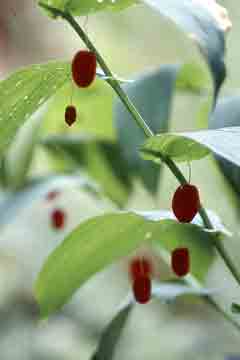 |
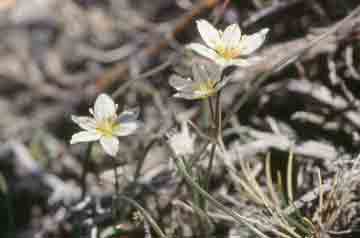 |
Common alpine lily, Lloydia serotina
(L.) Reichenb. (left). The alp lily (also known simply
as a “lloydia”) is found in the mountains of many of the
western states as well as in the mountains of Eurasia; it is a true alpine
plant. A few narrow, inconspicuous leaves and yellow-anthered, white, six-tepaled
flowers less than a quarter of an inch across, identify the plant as a lloydia.
It was named for Edward Lloyd (1660-1709), Welsh author, naturalist, and
curator of the Ashmolean Library of Oxford University, who discovered this
plant in Wales and recognized that alpine flora grew above treeline in the
Welsh mountains. The scientific species name, serotina, means
“late” or “autumnal”; a strange choice, for the flowers
bloom while there is snow on surrounding slopes.
Glacier lily, Erythronium
grandiflorum Pursh
var. grandiflorum (right). As with other well-loved
and widely distributed plants, this one has many common names: glacier lily,
avalanche lily, trout lily, dog-tooth violet, fawn lily, adder’s tongue
and others. Although we have not seen it growing south of Lemhi Pass (30
miles south-east of Salmon),it does occur in the mountains of the southeastern
part of the state. Lewis and Clark collected the glacier lily near their
Kooskooskee (Clearwater) River campsite on May 8, 1806 and later on the Lolo
Trail. A related white variety, var. candidum Piper, grows in northern
Idaho. |
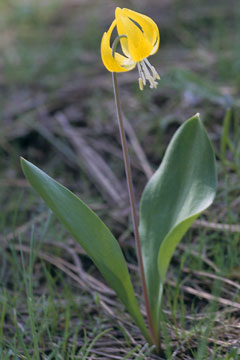 |














